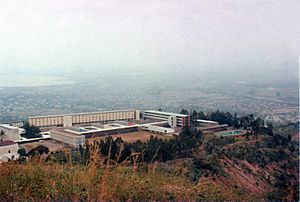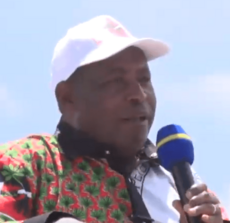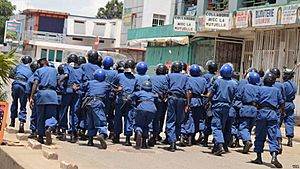Pierre Nkurunziza facts for kids
Quick facts for kids
Pierre Nkurunziza
|
|
|---|---|

Nkurunziza pictured in 2008
|
|
| President of Burundi | |
| In office 26 August 2005 – 8 June 2020 |
|
| Vice President |
See list
|
| Preceded by | Domitien Ndayizeye |
| Succeeded by | Évariste Ndayishimiye |
| Personal details | |
| Born | 18 December 1964 Bujumbura, Burundi |
| Died | 8 June 2020 (aged 55) Karuzi, Burundi |
| Resting place | Gitega |
| Political party | CNDD–FDD |
| Spouse |
Denise Bucumi
(m. 1994) |
| Children | 6 |
| Alma mater | University of Burundi |
| Signature |  |
| Website | Official website: http://www.presidence.gov.bi/ |
Pierre Nkurunziza (born December 18, 1964 – died June 8, 2020) was a politician from Burundi. He served as the ninth president of Burundi for nearly 15 years. His time as president lasted from August 2005 until his death in June 2020.
Nkurunziza was a member of the Hutu ethnic group. Before becoming a politician, he taught physical education. He joined the rebel group called the National Council for the Defense of Democracy – Forces for the Defense of Democracy (CNDD–FDD) during the Burundian Civil War. He became its leader in 2000. After the Civil War ended, the CNDD–FDD became a political party. Nkurunziza was then elected president. He served three terms, which caused some disagreements and public protests in 2015.
He decided not to run for re-election in 2020. Instead, he supported Évariste Ndayishimiye to become the next president. Nkurunziza passed away on June 8, 2020, just before his term officially ended. He was the longest-serving president in Burundian history.
Contents
Early Life and Education
Growing Up and Becoming a Teacher, 1964–1995
Pierre Nkurunziza was born on December 18, 1964, in Bujumbura, the capital city of Burundi. This was shortly after Burundi became independent from Belgium in 1962. He was one of six children. His family came from a place called Buye in Ngozi Province, where he spent his early years.
His father, Eustache Ngabisha, was a Hutu politician and a Catholic. He was elected to the National Assembly in 1965. He later became a provincial governor but was killed in 1972 during a time of violence. Nkurunziza's mother, Domitille Minani, was a Tutsi and a Protestant. Pierre Nkurunziza was considered Hutu.
Nkurunziza went to school in Ngozi and later studied in Gitega. He then attended the University of Burundi. In 1990, he earned a degree in physical education. At that time, he was not involved in politics. After graduating, he taught at a school in Muramvya. In 1992, he became an assistant lecturer at the university. He also coached football for two top teams, Muzinga FC and Union Sporting. He married Denise Bucumi in 1994.
Joining the CNDD–FDD, 1995–2005

In October 1993, the newly elected president, Melchior Ndadaye, was killed in an attempted takeover. This event led to fighting between Hutu and Tutsi groups and started the Burundian Civil War. Pierre Nkurunziza was still teaching at the University of Burundi. However, he had to leave in 1995 after many Hutu students were killed. He spent several years hiding in the bush.
During this time, he joined the National Council for the Defense of Democracy – Forces for the Defense of Democracy (CNDD–FDD). This was a group mainly supported by ethnic Hutus. By 1998, he became the General Secretary of the CNDD–FDD. He was in charge of both their political and military actions. He fought for their group and was known by the nickname "Pita." He nearly died in 2001 but believed his survival meant he was meant to lead the group. Nkurunziza became a Protestant and supported including Tutsis and other groups in the CNDD–FDD. All five of Nkurunziza's brothers and sisters died in the Civil War.
Nkurunziza became the president of the CNDD–FDD on August 28, 2000. He led the group as it worked towards a peaceful agreement with the government. In 2003, several agreements allowed the CNDD–FDD to become part of national politics. This also allowed Nkurunziza to reunite with his wife and family. He became a minister in the government of Domitien Ndayizeye. This position helped him prepare for the upcoming elections. He was re-elected president of the CNDD–FDD, which was now a political party, in August 2004. He became their candidate for the 2005 elections. These elections brought Nkurunziza and the CNDD–FDD to power. He became the President of Burundi.
Presidency of Burundi
First Term: 2005–2010
Nkurunziza became president on August 26, 2005. He quickly started several popular programs. He worked to rebuild Burundi based on agreements that shared government positions among Tutsi, Hutu, and the small Twa ethnic groups. The last Hutu rebel group, the PALIPEHUTU–FNL, stopped fighting in 2008.
Burundi became more involved with the African Union. In 2009, the country's large public debt was canceled by international groups. However, Nkurunziza's reputation began to suffer due to disagreements within his party and issues with corruption. Despite these challenges, Nkurunziza was re-elected for a second term in July 2010. He won by a large majority, but most opposition parties did not participate in the election.
Second Term and Public Protests: 2010–2015
During Nkurunziza's second term, people became more unhappy with his leadership. In June 2014, outdoor jogging was even banned. This was because the government worried that group exercise might be used for political meetings.
The biggest problem came on April 25, 2015. Nkurunziza announced he would run for a third term in the presidential elections that June. Many people believed this went against the rules set in the Arusha Accords, which limited presidential terms. This announcement caused large protests in Bujumbura and other areas. The protests led to violent clashes. However, the Constitutional Court ruled on May 5 that a third term was legal. The protests then grew, and dozens of people were killed.
On May 13, 2015, some soldiers tried to start a military uprising. This attempt failed after fighting in Bujumbura. Despite the instability and an ongoing boycott by opposition parties, the elections took place in July. Nkurunziza was re-elected for his third term.
Third Term and Later Years: 2015–2020
During Nkurunziza's third term, Burundi became more isolated from other countries. This was because of international concerns about the events that followed the 2015 protests. On August 4, 2015, he ordered the police to find those responsible for the death of his close ally, Lieutenant General Adolphe Nshimirimana.

Groups like the East African Community and African Union tried to help solve the conflict, but they were not successful. Nkurunziza's government became more isolated. In 2017, Nkurunziza withdrew Burundi from the International Criminal Court. He also supported changes to the constitution that would allow longer presidential terms. These changes were approved in a vote in May 2018. However, in June 2018, he announced that he would not seek a fourth term and would step down in 2020. That same year, the CNDD–FDD gave him the title of "Permanent Visionary."
In March 2019, three girls were arrested for drawing on a picture of the president. People around the world were very upset. Organizations like Human Rights Watch started an international campaign called #FreeOurGirls. This pressure made the government agree to release the three girls.
Before he resigned, Nkurunziza supported Évariste Ndayishimiye to become the next leader of the CNDD–FDD. This was before the elections in 2020. Ndayishimiye was seen as a close friend of Nkurunziza. The elections happened in May 2020. Nkurunziza's chosen candidate won by a large majority.
Death
Pierre Nkurunziza passed away on June 8, 2020, at the age of 55. He died at the Fiftieth Anniversary Hospital in Karuzi. The government of Burundi stated that he died from a heart attack. However, many people suspected he died from COVID-19. A week before his death, a Kenyan newspaper reported that his wife had flown to Nairobi, Kenya, for COVID-19 treatment.
Nkurunziza's death happened after the 2020 elections but before the new president was supposed to take office in August. In May 2020, it had been announced that he would continue to have an important public role as "Supreme Guide of Patriotism." He was also to receive a retirement payment and a house from the government. Burundi announced seven national days of mourning after his death. Other countries in the East African Community also observed official periods of mourning.
Images for kids
See also
 In Spanish: Pierre Nkurunziza para niños
In Spanish: Pierre Nkurunziza para niños



